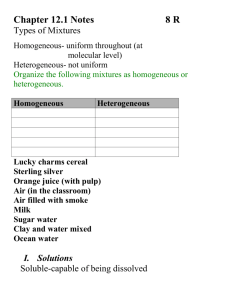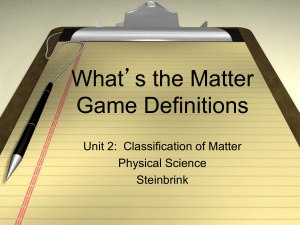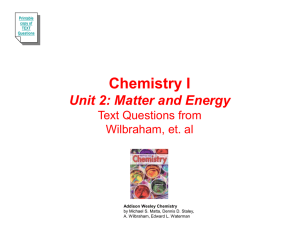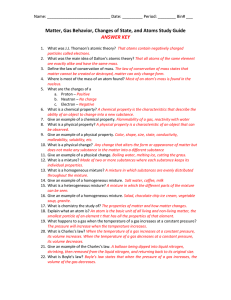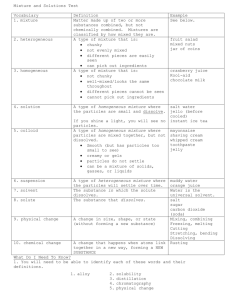Unit 1: Introduction to Chemistry
advertisement
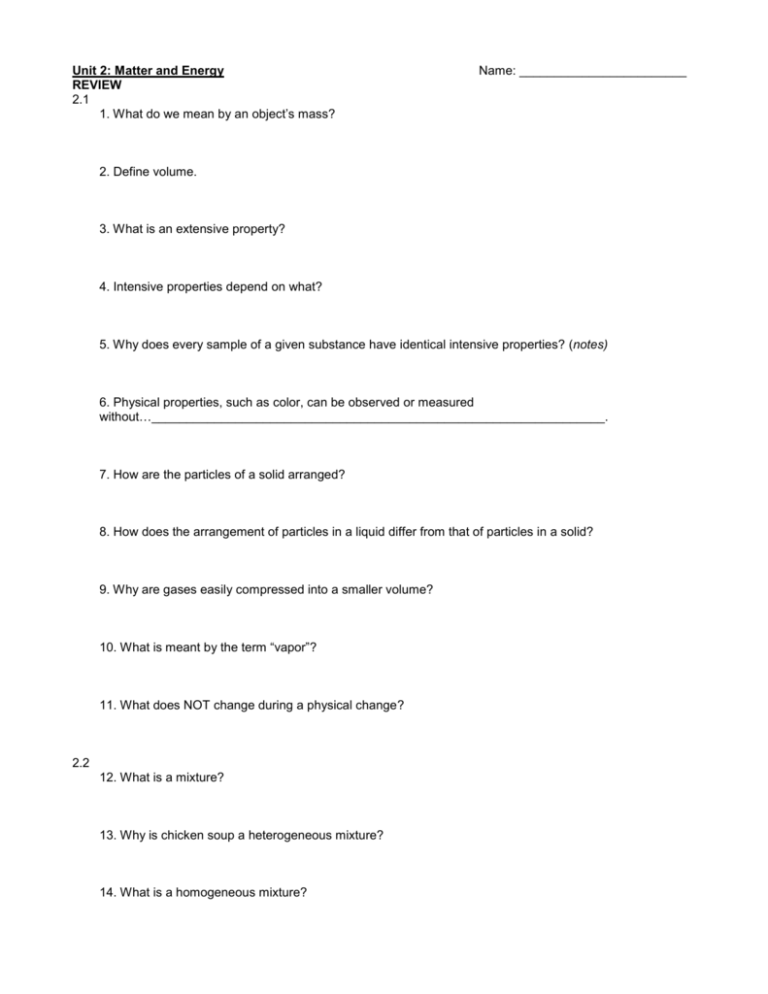
Unit 2: Matter and Energy REVIEW 2.1 1. What do we mean by an object’s mass? Name: ________________________ 2. Define volume. 3. What is an extensive property? 4. Intensive properties depend on what? 5. Why does every sample of a given substance have identical intensive properties? (notes) 6. Physical properties, such as color, can be observed or measured without…_________________________________________________________________. 7. How are the particles of a solid arranged? 8. How does the arrangement of particles in a liquid differ from that of particles in a solid? 9. Why are gases easily compressed into a smaller volume? 10. What is meant by the term “vapor”? 11. What does NOT change during a physical change? 2.2 12. What is a mixture? 13. Why is chicken soup a heterogeneous mixture? 14. What is a homogeneous mixture? 15. What is another name for a homogeneous mixture? 16. By definition, a homogeneous mixture consists of a ________ _______, while a heterogeneous mixture consists of… 17. What can be used to separate mixtures? (notes) 18. What is filtration, in chemistry? (notes) 19. Why do the solid substances that were dissolved in the water remain in the distillation flask? 2.3-2.4 20. What is an element? 21. To have a compound, two or more elements must be… 22. What can be broken down into simpler substances by chemical means? 23. A chemical change produces matter with… 24. Why is there no chemical process that will break carbon into simpler substances? 25. If there is more than one version of a sample of matter, you definitely have a… 26. What do chemists use to represent… …elements? …compounds? 27. The first letter of a chemical symbol is _________________. If there is a second letter, it is ________________. 28. Why is the formula for a compound always the same? (notes) 2.4 29. When can chemical properties be observed? 30. During a physical change, what NEVER happens? 31. What is the only way to be sure that a chemical change has occurred? 3.3-3.4 32. For a sample of pure water at 4oC, what is the ratio of its mass to its volume? Include the correct unit. 33. Write the equation for density. 34. Why can the density of a mixture vary? 35. What do experiments show about the relationship between volume and temperature? 36. Why does ice float? 15.3 37. What does it mean to say that metals are… …ductile? …malleable? 38. Most of the metallic materials you encounter are __________, which are… 39. Are there “many” or “few” alloys? 7.1 40. We often measure the amount of something by what three ways? 41. What is Avogadro’s number? 42. What term refers to the species present in a substance, whether atoms, molecules, or formula units? 43. For an element, define molar mass. (aka gram atomic mass) 44. What is the molar mass of magnesium? Include the correct unit. 7.3 45. What does the percent composition consist of? 46. What must the percents of the elements add up to? 47. You can use the percent composition to calculate what? 10.3 48. Why do solids NOT flow? 49. What happens to the organization of particles at the melting point? 50. Why do allotropes have different properties? 1. What is a monoatomic element? 2. What is a diatomic element? What are the 7 diatomic elements? 3. Zinc oxide (ZnO) is 80.3% zinc (Zn) and 19.7% oxygen (O). How many grams of each of these elements are there in a 75 g sample of ZnO? 4. The density of salt is 2.164 g/cm3. If a cube of salt has a mass of 54 g, what is the length of one side of the cube (in cm)? 5. Is density an extensive or intensive property of matter? Is density a physical or chemical property of matter? 6. 7. When ice melts, has a chemical or physical change occurred? Classify the following as exothermic or endothermic changes. freezing cold pack melting burning boiling condensation 8. How many atoms of lead (Pb) are in 78.5 g of lead? 9. 25 g of hydrochloric acid (HCL) is needed. Find the volume that must be measured out in a graduated cylinder if the density is 1.165 g/ml 10. What is the percent composition of carbon in Glucose, C6H12O6 ?



